(shield volcano 641 m / 2,103 ft)
Abu volcano is a group of 56 smaller volcanic centers with no individual large central volcano, located near the Japan Sea coast in southwest Honshu, Japan, 80 km west of Hiroshima.
The group, also known as the Abu Monogenetic Volcano Group (AMVG), covers 400 sq km and con... [
more info]
(stratovolcanoes 1718 m / 5,636 ft)
Adatara volcano is a group of overlapping stratovolcanoes east of Bandai volcano and located 15 km SW of Fukushima City. Its highest summit is Minowa-yama stratovolcano, north of Tetsu-zan, which is the currently active stratovolcano. The group forms a N-S directed elongated chai... [
more info]
(stratovolcano 1828 m / 5,997 ft)
Akagi or Akagisan volcano is a broad stratovolcano located in central Honshu, 110 km NNW of Tokyo. It is part of the Akagi Prefectural Par.
The volcano contains a 3 x 4 km diameter summit caldera which contains lake Ono in the NE.
It is uncertain whether the volcano ... [
more info]
(stratovolcanoes 1637 m / 5,371 ft)
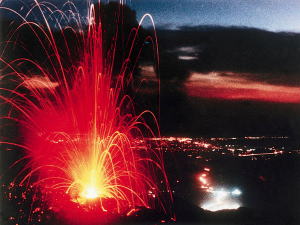
The eruption of Akita-Komagatake in Sep 1970 (source: http://www.qsr.mlit.go.jp/)
Akita-Komagatake volcano is an active volcano in northern Honshu. It is located 10 km east of Tazawa Lake, near the border of Akita and Iwate prefectures, and forms the southern extremity of the Towada-Hachimantai National Park.
The volcano consists of a main edifice cut b... [
more info]
(stratovolcano 1366 m / 4,482 ft)
Akita-Yake-yama volcano is an active stratovolcano in NW Honshu. It is one of several Japanese volcanoes named Yake-yama ("Burning Mountain").
Akita-Yake-yama is the most recently active of a group of overlapping volcanoes immediately west of the Hachimantai volcanic group... [
more info]
(complex volcano 2568 m / 8,425 ft)
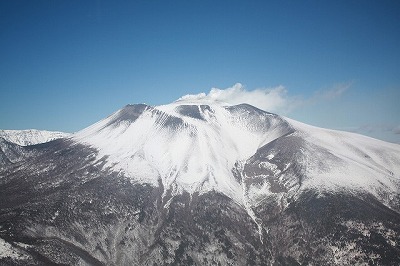
Asamayama volcano (JMA)
Asama (or Asamayama) volcano is the most active volcano of Honshu and one of the volcanoes with the longest recorded history of documented eruptions. It is located 130 km from Tokyo in central Honshu, overlooking the resort town of Karuizawa.
Asama's activity is typically e... [
more info]
(Stratovolcano(es) 1969 m / 6460 ft)
[
more info]
(stratovolcanoes 2035 m / 6,676 ft)
Azuma volcano is a group of small stratovolcanoes, shield volcanoes, domes and cinder cones in NE Honshu, Japan, west of Fukushima city, known as the Azumayama volcanic group.
Historical eruptions were mostly small phreatic eruptions from the Issaikyo volcano at the norther... [
more info]
(stratovolcano 1819 m / 5,968 ft)
Bandai volcano (or Bandaisan volcano), one of Japan's most known active volcanoes, is an complex andesitic stratovolcano rising above the north shore of Lake Inawashiro.
The volcano is located in the southern part of the NE Honshu volcanic arc.
The last magma was erup... [
more info]
(Pyroclastic cone 390 m / 1280 ft)
[
more info]
(stratovolcanoes 2233 m / 7,326 ft)
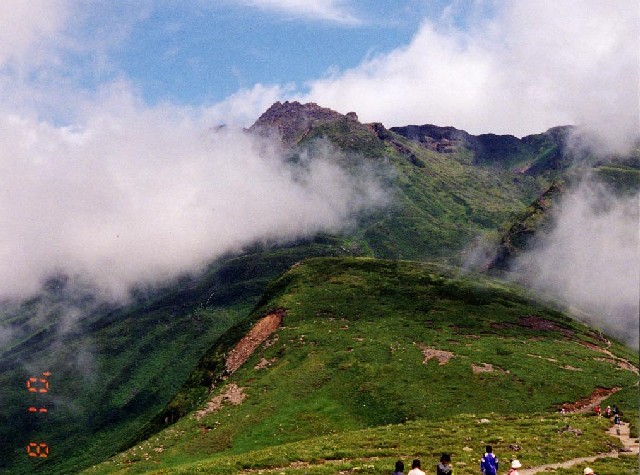
Chokai volcano
Chokai or Chokaisan volcano (鳥海山 Chōkai-san) is the largest volcano of NE Honshu.
It is a massive stratovolcano with a broad conical profile which is why it is called locally Akita-Fuji or Dewa-Fuji. Its height measures from the WNW elongated 15x20 km base about 2000 m.
more info]
(Stratovolcano(es) 1500 m / 4921 ft)
[
more info]
(Stratovolcano(es) 1485 m / 4872 ft)
[
more info]
(stratovolcano 1614 m / 5,295 ft)
Hachimantai (Hatimantai) volcano is a complex stratovolcano in northern Honshu, Japan, located at the front of the northern Honshu volcanic arc. It belongs to the Towada-Hachimantai National Park.
Hachimantai was originally the name of a small peak (1614m) in the northern ... [
more info]
(stratovolcanoes 1585 m / 5,200 ft)
Hakkoda (or Hakkodasan) volcano is a group of 14 stratovolcanoes and lava domes south of Mutsu Bay at the northern end of Honshu Island, Japan.
There are fumaroles and hot springs at Ido-dake and several other locations. 3 minor phreatic eruptions were documented from Jigok... [
more info]
(complex volcano 1438 m / 4,718 ft)
Hakone (Hakoneyama) volcano is located 80 km SW of Tokyo. It is a massive stratovolcano truncated by 2 overlapping calderas, the largest being 11 x 10 km wide. It contains several younger vents, mostly lava domes, on a SW-NE trend cutting through the center of the caldera. The Ka... [
more info]
(stratovolcano 2702 m / 8,865 ft)
Haku-san volcano (白山, or Mount Haku, Hakusan) is one of the 3 holy mountains in Japan (along with Fuji and On-take). It is a stratovolcano in central Honshu 260 km NW of Tokyo.
the volcano last erupted in 1659, but many eruptions have been recorded during the 1000 years pri... [
more info]
(Stratovolcano(es) 1757 m / 5764 ft)
[
more info]
(stratovolcano 1449 m / 4,754 ft)
Haruna volcano a stratovolcano located in central Honshu, 110 km NW of Tokyo. The volcano contains a small summit caldera with a symmetrical post-caldera cone (Haruna Fuji) and Lake Haruna in the western side of the caldera.
The most recent eruptions, dated to the 6th cent... [
more info]
(caldera 516 m / 1,693 ft)
Hijiori volcano is a caldera about 15 km northeast of Gassan volcano in Yamagata Prefecture in northern Honshu, Japan.
It formed about 12,000 years ago during an eruption that produced dacitic pyroclastic flows and tephra fall to the east until the Pacifi Ocean. A lava dome... [
more info]
(stratovolcano 2356 m / 7,730 ft)
Hiuchi (or Hiuchigatake) volcano is a stratovolcano located in Niggata Prefecture, 140 km NNW of Tokyo. It is part of the Nikko National park, one of Japan's most scenic regions, known for Lake Ozenuma, a popular hiking destination in the park.
The last eruption was in 1544... [
more info]
(stratovolcano 1625 m / 5,331 ft)
Iwaki (or Iwakisan) volcano is a large symmetrical stratovolcano and the NW-most active volcano in Honshu, Japan. Because of its shape, it has been called the Fuji-san of the Tsugaru district.
Iwaki contains a 2-km-wide summit crater which is filled by a lava dome flanked b... [
more info]
(complex volcano 2041 m / 6,696 ft)
Iwate (or Iwatesan) volcano is a symmetrical stratovolcano in northern Honshu, Japan, 20 km northwest of Morioka City.
It consists of 2 cones, the older western Nishi-Iwate and the younger eastern summit Higashi-Iwate. The older volcano to the west is truncated by a calder... [
more info]
(pyroclastic cones 1406 m / 4,613 ft)
Izu-Tobu volcano is a group of volcanic vents with cinder cones, lava flows, domes and tephra deposits on the NE Izu peninsula 80 km SW of Tokyo.
The Izu-Tobu volcanic group covers an area of 400 sq km and contains many submarine volcanoes offshore of the peninsula. Most o... [
more info]
(cinder cone, maars 355 m / 1,165 ft)
Kanpu volcano (also known as Ichinomegata) is a small cone on the Oga Peninsula NW of Akita City. [
more info]
(stratovolcanoes 2530 m / 8,300 ft)
Kita-Yatsugatake (North Yatsugatake) is a group of stratovolcanoes and lava domes at the NW end of the Yatsugatake volcanic massif. The Kita Yatsugatake volcanic group is contains the volcanoes Tateshina, Yokodake, Shimagareyama, Chausu-yama and Futago-mine.
Yokodake lava d... [
more info]
(Stratovolcano(es) 1296 m / 4252 ft)
[
more info]
(stratovolcano 628 m / 5,341 ft)
Kurikoma (Kurikomayama) volcano is a complex stratovolcano cut by a 4 km wide caldera located in northern Honshu, Japan. It contains the Tsurugi-dake lava dome, a central post-caldera cone, known as the site of former sulfur mining.
Minor phreatic eruptions have occurred i... [
more info]
(Stratovolcano(es) 1764 m / 5787 ft)
[
more info]
(stratovolcanoes 2171 m / 7,123 ft)
Kusatsu-Shirane volcano is a complex of overlapping cones and 3 lake-filled craters (Karagama, Yugama, Mizugama) at the summit. It is located 150 km NW of Tokyo.
All historical eruptions have consisted of phreatic explosions from the acidic crater lakes or their margins. T... [
more info]
(Stratovolcano(es) 1671 m / 5482 ft)
[
more info]
(Pyroclastic cone 749 m / 2457 ft)
[
more info]
Megata volcano is a group of 3 small explosion craters (maars) along the tip of the Oga Peninsula in NW Honshu. Recent studies have shown that they have been active during the past 10,000 years. [
more info]
(stratovolcano 2621 m / 8,599 ft)
Midagahara (prev. referred to as Tate-yama) volcano is located in the southeastern area of Toyama Prefecture, Japan. It is surrounded by high peaks of the North Japan Alps and named for the granite-and-gneiss peak of Tate-yama (立山), which lies immediately to the east and forms o... [
more info]
(stratovolcano 3776 m / 12,388)
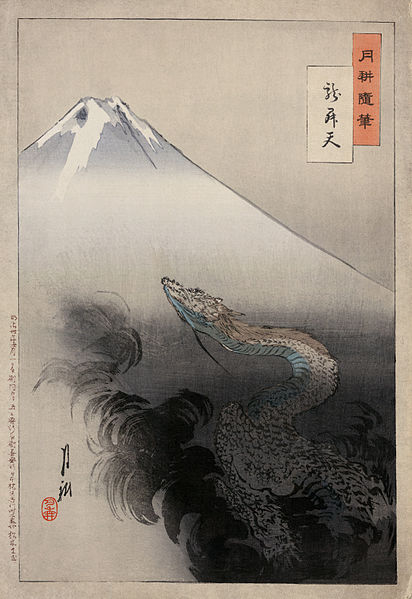
"Ryu sho ten" or "Ryu shoten" (Dragon rising to the heavens), also known as "Gekko Zuihitsu" (Gekko's Sketch), a Ukiyo-e print from Ogata Gekko's Views of Mt. Fuji. A dragon rises out of smoke near Mt. Fuji, ascending towards the sky.
Mount Fuji (Fuji-san, 富士山 in Japanese) is the highest volcano and highest peak in Japan and considered one of the 3 Holy Mountains (along with Mount Tate and Mount Haku). Fuji is a perfect, beautiful stratovolcano about 60 miles south-west of Tokyo, with an exceptionally symmetri... [
more info]
(stratovolcano 781 m / 2,562 ft)
Mutsu-Hiuchi-dake volcano on the Shimokita Peninsula is the northernmost volcano on Honshu, Japan.
The andesitic-dacitic stratovolcano is probably extinct. It was active between 700,000 to 50,000 years ago, but there is still fumarolic activity. [
more info]
(Pyroclastic cone(s) 104 m / 341 ft)
[
more info]
(stratovolcano 2446 m / 8,025 ft)
Myoko volcano (or Myokosan volcano) is a steep basaltic-to-dacitic stratovolcano north of Nagano City that overlooks the popular resort of Lake Nojiri below its SE flank.
Myoko's summit is formed by a lava dome filling most of a 3-km-wide caldera which is widely breached t... [
more info]
(stratovolcano 2486 m / 8,156 ft)
Nantai (or Nantaisan) stratovolcano is located north of Lake Chuzenji in Nikko National Park, Honshu, and close to the famous temple complex at Nikko.
Lake Chuzenji was formed by eruptions of Nantai volcano which produced lava flows that blocked the Daiya River. The dramati... [
more info]
(Pyroclastic cone 106 m / 348 ft)
[
more info]
(caldera 470 m / 1,542 feet)
Narugo (also known as Naruko) volcano is a caldera NW of Sendai city, northern Honshu, Japan. There is only one known historical eruption from Narugo volcano, which was in 837 AD.
Katanuma crater lake is one of the most acid crater lakes of Japan, with a pH of 1.6. Shurado... [
more info]
(stratovolcanoes 1915 m / 6,283 ft)
Nasu (or Nasudake) volcano at the northern end of Kanto Plain in central Honshu is a group of 3 larger and older and 3 smaller, young stratovolcanoes. The younger cones are called Asahi-dake, Futamata-yama, and Chausu-dake, the youngest of the volcanoes. Chausu-dake started to gr... [
more info]
(lava dome 2400 m / 7,874 ft)
Niigata-Yake-yama volcano is located in the Niigata prefecture in central Honshu, near the Japan Sea. It is one of several Japanese volcanoes named Yake-yama ("Burning Mountain"). It is a very young andesitic-to-dacitic lava dome. A large explosive eruption in 887 AD produced a m... [
more info]
(shield volcano 2578 m / 8,458 ft)
Nikko-Shirane (or Nikko-Shiranesan) volcano is a small andesitic volcano located NW of scenic Lake Chuzenji in Nikko National Park. The volcano contains 4 lava domes sitting on top of a shield volcano (Keizuka-yama).
All historical eruptions, recorded during the 17th-20th c... [
more info]
(stratovolcanoes 3026 m / 9,928 ft)
Norikura volcano (乗鞍岳, Norikura-dake) in central Honshu is the 3rd highest volcano in Japan. It has been last active about 2000 years ago [
more info]
(Pyroclastic cone 180 m / 591 ft)
[
more info]
(shield volcano, caldera 1100 m / 3,609 ft)
Numazawa volcano has a small 1.5 x 2 km wide caldera which formed during a major eruption about 4600 years BP, producing large quantities of dacitic-to-rhyolitic pumice fall and flow deposits. The caldera is filled by a lake. [
more info]
(Stratovolcano(es) 1478 m / 4849 ft)
[
more info]
(Pyroclastic cone(s) 1310 m / 4298 ft)
[
more info]
(shield volcano 151 m / 495 ft)
Oki-Dogo volcano is a complex of shield volcanoes forming small islands north of the SW Honshu city of Matsue in the Japan Sea off the west coast of Japan. Most of the volcanic activity took place 800,000-300,000 years ago, but there has probably been activity during the past 10,... [
more info]
(lava domes 2367 m / 7,766 ft)
Omanago volcano consists of 5 closey spaced lava domes in Nikko National Park. They are located north and NW of Nantai volcano.
The highest of the dacitic domes is 2367-m-high Omanago, which later erupted andesitic lavas. Mitsu-dake lava dome, which overlooks the hot spring... [
more info]
(caldera 769 m / 2,523 ft)
Onikobe volcano is a caldera SW of Kurikoma volcano in northern Honshu, Japan. It is probably extinct, but there are prominent geysers and hot springs in the caldera, known since about 1700 years ago.
In 1938 a new geyser (Benten geyser, or generally called Onikobe geyser) ... [
more info]
(complex volcano 3063 m / 10,049 ft)
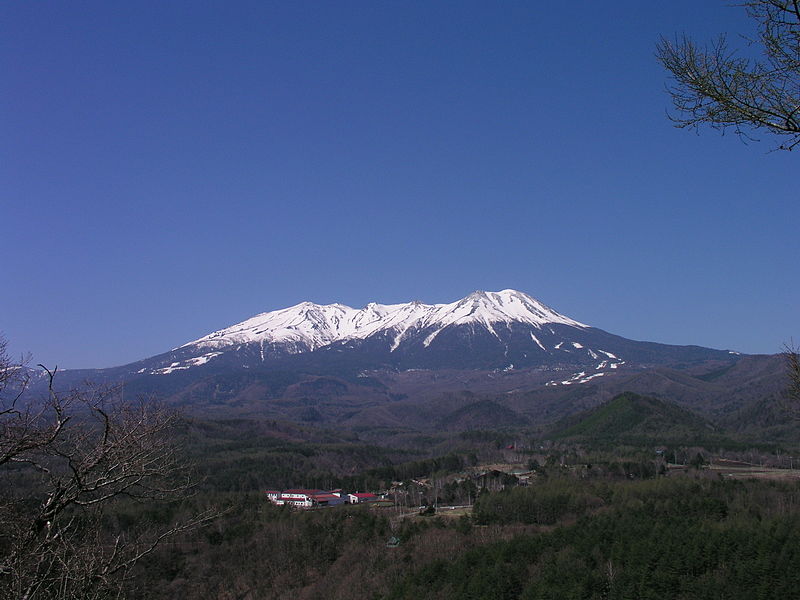
Mt.Ontake, viewed from Kuzo Pass of Route 361 (pictrure: Atsushi Ueda / Wiki Commons)
On-take, or correctly Ontake-san (御嶽山), is a massive stratovolcano and the second highest in Japan. It is located at the southern end of the Northern Japan Alps.
Its first historic eruption occurred in 1979. A landslide in 1984 was not related to an eruption and produced a ... [
more info]
(stratovolcano 879 m / 2,884 ft)
Osore-yama volcano (also known as Osorezan) is an active stratovolcano on the Shimokita Peninsula in northernmost Honshu, Japan.
It is known locally also as Yake-yama, or "Burning Mountain". Older residents reported that large fires and clouds were sometimes seen from the ... [
more info]
(stratovolcano 1126 m / 3,694 ft)
Sanbe (also written as Sambe, Sanbe-san) volcano is a complex stratovolcano in SW Honshu, along the Japan Sea coast. It contains a small 1 km diameter caldera. Its summit at the northern end of the complex is called O-Sanbe.
A well-known feature are the Sanbe-onsen Hot Spr... [
more info]
(Stratovolcano? 1289 m / 4229 ft)
[
more info]
(shield volcanoes 2041 m / 6,696 ft)
Shiga volcano is a group of small andesitic shield volcanoes and pyroclastic cones immediately north of Kusatsu-Shirane volcano.
The last eruptions were about 250,000 and 10,000 years ago. The complex was built on top of a large lava plateau that was erupted between about 3... [
more info]
(Stratovolcano(es) 2469 m / 8100 ft)
[
more info]
(Stratovolcano(es) 2144 m / 7034 ft)
[
more info]
(stratovolcano 1795 m / 5,889 ft)
Takahara (or Takaharayama) volcano is a small stratovolcano located SW of Nasu volcano and NNW of Utsunomiya city in central Honshu.
The basaltic-to-dacitic volcano is constructed within the Shiobara caldera. It contains a number of small lava domes, including the symmetri... [
more info]
(caldera 1159 m / 3,802 ft)
Towada volcano is a collapsed large stratovolcano with a 11 km wide dramatic caldera in northern Honshu, Japan. The caldera is occupied by Lake Towada, Japan's largest caldera lake.
The caldera formed during repeated collapse during 6 major eruptions between 53,000 and 13,... [
more info]
(Pyroclastic cone(s) 301 m / 988 ft)
[
more info]
(shield volcanoes 2924 m / 9,593 ft)
Washiba-Kumonotaira volcano in the Northern Japan Alps is a group of small shield volcanoes and possible lava domes. The volcanoes are located in a remote part of the Chubu Sangaku National Park.
The last activity was from Washiba-ike volcano less than 12,000 years ago. [
more info]
(stratovolcanoes 2455 m / 8,054 ft)
Yake-dake volcano is a small stratovolcano near the popular resort of Kamikochi in the Northern Japan Alps. It is one of several Japanese volcanoes named Yake-dake or Yake-yama ("Burning Peak" or "Burning Mountain").
It has had frequent small to moderate phreatic eruptions ... [
more info]
(Stratovolcano(es) 2899 m / 9511 ft)
[
more info]
(Pyroclastic cone(s) 967 m / 3173 ft)
[
more info]
(comlex volcano 1841 m / 6,040 ft)
Zao (or Zaozan, Zaosan) volcano is the most active volcano of northern Honshu and consists of a group of stratovolcanoes forming the crest of the divide between the Pacific Ocean and the Japan Sea.
The older parts of the complex are Ryuzan volcano in the west and Byobu and... [
more info]









